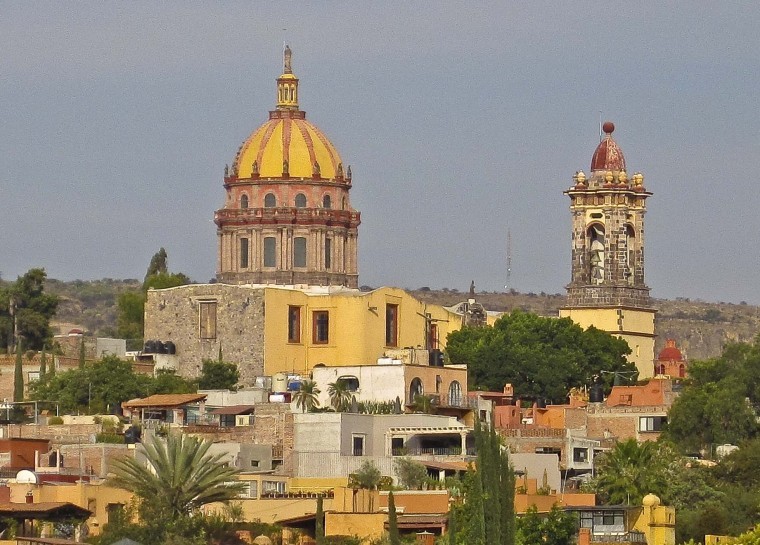Take a walk with me up a narrow cobbled street hemmed in by centuries-old masonry walls with massive carved wooden doors and sculpted trim around the windows. At the top of the hill, we reach the town square bustling with locals chatting on benches. Just across the plaza is a 450-year-old church with gothic arches reaching up toward heaven. Inside the church, we walk beneath an awesome succession of altars trimmed in gold leaf and decorated with a gaudy array of carvings and paintings.
Where are we? In a hilltop Tuscan town? Perhaps a village perche in Provence, France?
I have been to the several of the places in Mexico where we gringos go, but I have never been to a part of Mexico where Mexicans live. San Miguel de Allende, in the geographic center of the country, was a delightful discovery that dissolved my narrow preconceptions about Mexico.
San Miguel de Allende attracts a lot of tourists, but mostly Mexican tourists in search of their own history. San Miguel and nearby Dolores Hidalgo are the birthplaces of the Mexican War of Independence. In September 1810, under the leadership of Father Miguel Hidalgo and Ignacio Allende, a group of insurgents assembled in Dolores and marched to San Miguel. The revolution was on. Hidalgo and Allende were killed early in the war, and their severed heads, along with two others, would sit atop posts at the corners of a building in Guanajuato until the war ended 10 years later. Their names were added to the town names of Dolores and San Miguel to honor their roll in the fight for Mexican independence.
After World War II, American war veterans and artists came to San Miguel and built an artistic community that continues to grow. Now, San Miguel has a significant expatriate population of Americans and Canadians attracted by mild weather and the town’s artistic and cultural variety.
My wife is an artist, so San Miguel de Allende appeared on her radar screen some time ago. It was one of those places on our bucket list that we would probably never get to, but sometimes the fates work in your favor. Through a bit of unexpected serendipity, two friends who were invited to San Miguel, asked us along.
We learned our first lesson about San Miguel when we stopped in front of the house where we would stay. The numbered door, one of many in a block-long stuccoed wall, left us wondering what was on the other side. But it was lovely. All through San Miguel, modest doors on any city street often hide amazing courtyards and gardens.
Like Paris or Florence, Italy, San Miguel beckons you to lace up comfortable walking shoes and just go, go, go. We headed for the hilltop where the Parroquia, the most elaborate and conspicuous of San Miguel’s myriad Catholic churches, overlooks the town. In front of the Parroquia is the Jardin Principal, a large plaza of manicured gardens humming with vendors and gossiping town folks.
This is the cultural and historical heart of the town. From here, craft shops, great restaurants, magnificent churches and historical buildings are a stroll away. The downtown walking tour brought San Miguel’s revolutionary drama to life: Ignacio Allende’s house, the plaza where insurgents gathered, and the wall against which many were shot by a firing squad (note the filled-in bullet holes).
I suppose the Mexico of CNN — drug cartel killings, corruption, danger — is out there somewhere, but every moment we spent in San Miguel was a revelation. Great weather, friendly people, rich history, and sights with a European flair are right here in our hemisphere.










